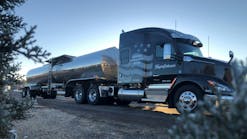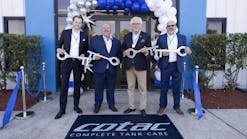With the vast array of chemicals, cleaning solutions and wash facilities, communication is key to avoiding costly mix-ups
TANK cleaning is a growing industry with hundreds of providers large and small spread across the country, and an equally vast array of cleaning chemicals and methods, and types of containers to clean.
That variety often is problematic for carriers and wash facilities, creating the risk of costly, and potentially lethal, product contamination—and the most effective solution for clearing up confusion is communication.
“(Contamination) is a serious situation in our industry that we need to eliminate,” said Travis O’Banion, formerly the vice president of environmental health and safety for Quala’s sustainable container solutions. “We’re not talking about the different liabilities here. We’re talking about, ‘What do we do from a communication point of view to eliminate contaminations?’”
O’Banion, Ed Wickham, a sales representative with A-One Chemicals, and Terry Kolacki, director of environmental health, safety and sustainability for Superior Carriers, attempted to answer that question by outlining common causes of product contamination in tank trailers and proactive prevention measures in “Preventing Contamination: Improving Communication Between Carriers and Cleaning Facilities” during NTTC’s 2019 Safety & Security Council Meeting.
Contamination causes
Wickham, who traced the tank wash industry’s roots to 1980s deregulation intended to help prevent product contamination in transportation, opened the presentation by differentiating chemical contamination from “cross-contamination” in the food industry, which refers to the unintentional transfer of microorganisms or chemical contaminants, including allergens and other foreign substances, from food, person or object to another food product, potentially leading to food poisoning.
In the bulk liquid transportation industry, contamination—defined as the action or state of making or being made impure by polluting or poisoning—typically results from the mixing of two different chemical products hauled at different times in the same container, and often stems from a failed cleaning.
Common causes of contamination include prior product sensitivity, a poor tank cleaning that didn’t remove all traces of the previous chemical, lack of communication between the carrier and cleaning facility, improper handling of associated pumps, hoses and fittings, and the lack of understanding of the potential risks of a particular job by the scheduler or dispatcher who assigned it.
“As a cleaner, you need to understand what the dispatcher’s doing, and the dispatcher needs to understand what the cleaner’s doing, so they can both be on the same page with equal expectations,” Wickham said.
O’Banion said carrier/cleaning facility communication is a “two-way street,” with both parties equally responsible for sharing key information. Wickham said “increased and constant” communication between tank cleaning facilities, dispatchers and customers is a critical element in contamination prevention.
“It is as much the cleaning facility’s responsibility to reach out, when we don’t have the information we think we might need, as it is the carrier’s, and we must clearly communicate from start to stop,” O’Banion said.
As a vendor of cleaning services, O’Banion said the first step is to gather all essential information about the product to be cleaned. Then the vendor’s chemical experts can analyze the chemistry, determine how it affects a specific carrier’s tanks, and how it adheres during transportation based on temperature, time of year and time in the tank, and select the correct cleaning solution and process.
“If we don’t have what we need to know about a particular product, or even perhaps a material that’s not a product—it could be considered a waste—well then shame on us,” he said. “We’ve got to get the SDS (safety data sheet). We’ve got to get the waste profile, when it’s not a pure product, and we’ve got to understand what we’re dealing with.”
Then the cleaner’s experts need to make sure the “boots on the ground,” the technicians who are doing the cleaning, receive all the same information.
“It’s great that we’ve got the chemists sitting and looking at this, it’s great that we’re evaluating this through all the chemistry that we’re so smart about doing, but if we’re not telling our (cleaning technicians) how to (apply) this in a clear and concise way … we’ve dropped the ball again,” O’Banion said.
Contamination prevention
Proactive measures tank cleaning facilities can take to eliminate product contamination include:
• Educating, communicating
• Creating prior product databases
• Choosing the right chemicals
• Establishing standard processes
• Spot checking mechanical cleaning equipment
• Double-checking associated tank equipment, including pumps, hoses and fittings
• Implementing standard operating procedures for final inspections
Education—Training is a key factor in contamination prevention, and not just for chemical experts and managers.
If the scheduler or dispatcher doesn’t understand the potential risks associated with a product, they likely don’t understand how long the cleaning will take, creating tight deadlines that are impossible to meet.
If technicians aren’t adequately trained, they might not have a healthy enough respect for certain chemicals, or the confidence to say something if they see a co-worker engaged in unsafe behavior.
Database—Facilities that establish a prior product database help ensure the best prior product management.
Chemicals—Wickham said it’s critical to choose the appropriate chemicals from an experienced vendor who understands unique cleaning processes, and the limitations of certain cleaning facilities and personnel, and can assist in selecting the right cleaning agents for the products the facility cleans.
“There is so much behind-the-scenes R&D and laboratory work that goes into testing different prior cargoes in order to come up with stuff that best helps (tank washers) and your equipment,” Wickham said. “If everyone knew how much of that goes on behind the scenes, it’d probably blow your minds.”
Standards—Creating standard cleaning processes helps ensure all tanks are cleaned with the right cleaning agent for the prior cargo. This information can be added to the company’s database.
Spot checks—Regularly inspect the mechanical tank wash equipment. Make sure the spinner’s turning, and everything else is in proper working order, because even if the chemical is properly identified and the correct solution is selected, if the equipment malfunctions during the wash, the cleaning will fail.
“Make sure that all of your cleaning equipment systems are operating properly,” Wickham said. “Periodically check the pH of your rinse waters to make sure adequate rinsing has been done and the right times are used, so you can increase or decrease to maximize your operation, and check your pump pressures periodically as well.
“You should know what they started at, and then you should know where you’re at now, and be able to determine the need for repair or maintenance based on what the operating pressure is.”
Tank equipment—Pay close attention to gaskets, plugs, valves, caps, hoses, etc, which can be difficult to clean and track, and make sure any equipment that is removed for cleaning is returned to the correct tank.
“It’s difficult to take a trailer that has top-loaded a number of latex or adhesive loads and clean it to go load acetone/MEK blend,” Wickham said. “You need to communicate that to the tank wash, so they can take apart all those (valves, gaskets, fittings) to make sure you don’t have an opportunity for contamination.”
Final inspection—Standardize final inspections so steps are not forgotten. If every other aspect of the tank cleaning falls apart, the final inspection should help illuminate any problems, and provide an opportunity to correct any issues and prevent contamination through additional cleaning.
Digital inspection equipment is helpful here. Cameras can detect issues that are difficult to see with the naked eye, they help keep technicians out of confined spaces, and they also allow for documentation of the container’s condition at the time of cleaning, which is particularly important for ISO customers.
With food-grade cleaning, cameras also help prevent human contamination of a container after it’s cleaned.
Common issues
Cleanout caps continue to be a source of consternation for carriers.
Kolacki advocates for tanks without cleanouts, and said Superior is looking to add tanks without them to its trailer fleet to keep drivers safer. He said he’d like to see tank washes update equipment with pumps and nozzles designed to hit hard-to-reach areas, including ports in the front and rear heads.
Another issue with caps and gaskets, especially if they’re thrown into a bucket at the cleaning facility, is making sure they’re returned to the correct tank.
“With gasketing, making sure it’s the equipment that came off the trailer is very key,” Kolacki said.
“The other thing we’ve been struggling with on the carrier side is cross-threaded cleanout caps. So I just can’t say enough to all of my drivers about making sure they remove the cleanout cap every time they’re up there, and looking to make sure the gasket’s in there, and I believe it’s five or six turns that need to be completed before it’s tight.”
Cleaning hoses also is tricky, especially with equipment checked in afterhours.
O’Banion said Quala tries not to pressure wash hoses.
Wickham, whose company builds and sells vats specifically for hose, said the solution that takes a specific product out of the tank should remove it from the hose, too, but a worm system with a brush is another effective safeguard against residue left in the hose contaminating product in the tank.
As for afterhours check-ins, Kolacki said his previous employer used a tag system for making sure hoses and tanks stayed together at the cleaning facility, with separate designations for caustic and phenol product. The company supplied the tags, and the drivers zip-tied them on as necessary.
Other issues mentioned were tanks entering the wrong wash and tank sweating.
If an aluminum tank is caustic washed, despite warnings on the tank, that’s likely a communication issue, Wickham said; and water collecting in a tank often is a process problem that can be caught and eliminated with a moisture check before the tank leaves the facility, O’Banion said.
“You can’t always control the temperature in the environment, but you can control the temperature of the trailer when it leaves the rack,” O’Banion said.









